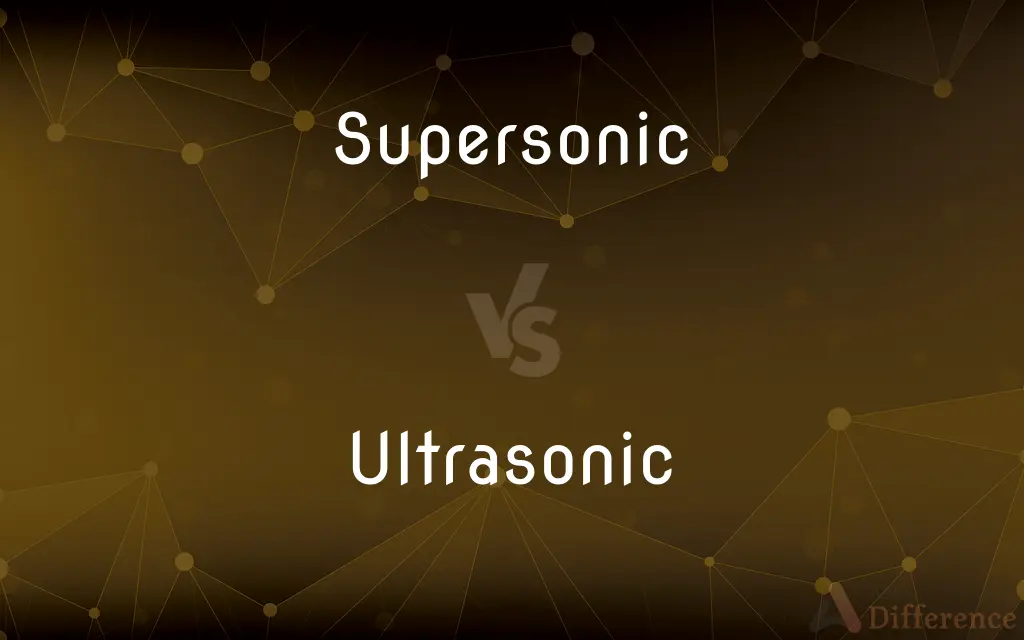Supersonic vs. Ultrasonic — What's the Difference?
By Urooj Arif & Fiza Rafique — Updated on March 18, 2024
Supersonic refers to speeds above the speed of sound in air, while ultrasonic denotes sound frequencies above the human hearing range.

Difference Between Supersonic and Ultrasonic
Table of Contents
ADVERTISEMENT
Key Differences
Supersonic is a term related to speed, especially in the context of objects moving faster than sound, typically measured at about 343 meters per second at sea level. Ultrasonic, however, pertains to sound waves with frequencies higher than 20,000 Hz, which is beyond the upper limit of human hearing.
While supersonic speeds are significant in aerospace and military applications, ultrasonic frequencies are utilized in medical imaging, cleaning, and industrial non-destructive testing. The former involves phenomena like sonic booms when transitioning through the sound barrier, whereas the latter employs high-frequency sound waves for practical applications without causing audible disturbance.
The study and application of supersonic technology focus on overcoming air resistance and minimizing shock waves that can affect aircraft structure and performance. In contrast, ultrasonic technology emphasizes the precision use of sound waves, such as in sonography, where images of internal body structures are produced using reflected sound waves.
Supersonic motion can lead to unique aerodynamic challenges, including increased drag and heat generation, requiring advanced materials and designs for aircraft. Ultrasonic waves, on the other hand, interact with materials at a microscopic level, allowing for applications in cleaning delicate instruments or promoting chemical reactions in industrial processes.
Both supersonic and ultrasonic technologies represent advancements in their respective fields, with the former revolutionizing travel and military capabilities and the latter enhancing medical diagnostics, cleaning, and industrial efficiency.
ADVERTISEMENT
Comparison Chart
Definition
Speeds exceeding the speed of sound
Sound frequencies above 20,000 Hz
Application Field
Aerospace, military
Medical imaging, industrial cleaning, non-destructive testing
Key Phenomena
Sonic boom, increased drag
High-frequency vibrations, non-audible sound
Technology Focus
Overcoming air resistance, minimizing shock waves
Precision use of sound waves, imaging, and cleaning
Impact
Revolutionizes travel and military capabilities
Enhances medical diagnostics, cleaning, and industrial processes
Compare with Definitions
Supersonic
Involves phenomena like sonic booms.
Supersonic jets produce a sonic boom when they break the sound barrier.
Ultrasonic
Frequencies above human hearing range.
Ultrasonic waves are used in sonar equipment to map the ocean floor.
Supersonic
Revolutionizes travel and military capabilities.
Supersonic technology has significantly reduced travel time across continents.
Ultrasonic
Non-audible sound used in various applications.
Ultrasonic pest repellents emit frequencies that deter pests without bothering humans.
Supersonic
Requires advanced materials for aircraft.
Supersonic aircraft use heat-resistant materials to withstand high-speed travel.
Ultrasonic
Employed in industrial cleaning.
Ultrasonic cleaners use high-frequency sound waves to remove dirt from delicate instruments.
Supersonic
Traveling faster than the speed of sound.
The Concorde was one of the first passenger aircraft to achieve supersonic flight.
Ultrasonic
Utilized in medical imaging.
Ultrasound scans are a common ultrasonic application for viewing a fetus during pregnancy.
Supersonic
Significant in aerospace and military.
Supersonic missiles offer strategic advantages in modern warfare.
Ultrasonic
Enhances diagnostics and efficiency.
Ultrasonic testing is crucial for detecting flaws in materials without causing damage.
Supersonic
Involving or denoting a speed greater than that of sound
The tip speed of the upwind blade becomes supersonic
Supersonic aircraft
Ultrasonic
Of or involving sound waves with a frequency above the upper limit of human hearing.
Supersonic
Having, caused by, or relating to a speed greater than the speed of sound in a given medium, especially air.
Ultrasonic
Of or relating to acoustic frequencies above the range audible to the human ear, or above approximately 20,000 hertz.
Supersonic
Of or relating to sound waves with a frequency above the range audible to the human ear; ultrasonic.
Ultrasonic
Of, relating to, or involving ultrasound.
Supersonic
(of a speed) Greater than the speed of sound (in the same medium, and at the same temperature and pressure).
Ultrasonic
(acoustics) Beyond (higher in frequency than) the range of sound perceptible to the human ear; with a frequency of 20 kilohertz or higher.
Supersonic
Ultrasonic, having a frequency too high to be audible.
Ultrasonic
Having frequencies above those of audible sound
Supersonic
An aircraft that can travel at the speed of sound.
Supersonic
Moving at a speed greater than the speed of sound in air; - this speed varies with altitude, since the speed of sound varies with altitude, as well as with temperature and humidity, being approximately 1129 feet per second at sea level and 984 feet per second at 16 miles altitude.
Supersonic
Capable of moving at speeds higher than the speed of sound; - of aircraft.
Supersonic
(of speed) greater than the speed of sound in a given medium (especially air);
A supersonic bomber flies so fast that it must release its bombs while the target is still over the horizon
Aircraft flying at subsonic speeds
Supersonic
Having frequencies above those of audible sound
Common Curiosities
What are the safety concerns with supersonic and ultrasonic technologies?
For supersonic, noise and environmental impact are major concerns, while ultrasonic applications must ensure that the intensity and exposure do not harm human tissue or disrupt electronic devices.
How do supersonic objects affect the environment?
Supersonic objects can produce sonic booms, which are loud and can potentially cause discomfort or damage to structures in populated areas.
Why are supersonic flights not more common for commercial air travel?
Challenges such as noise pollution, high fuel consumption, and the need for specialized materials make supersonic flights less practical for widespread commercial use.
Are there any common uses for both supersonic and ultrasonic technologies?
While their applications differ significantly, both technologies push the limits of speed and frequency for advancements in their respective domains, such as transportation and diagnostics.
How have ultrasonic technologies impacted industrial processes?
Ultrasonic technologies have improved efficiency and safety in cleaning, material inspection, and promoting chemical reactions, among other applications.
Can humans hear ultrasonic sounds?
No, ultrasonic frequencies are above the human hearing range, typically above 20,000 Hz.
What defines the threshold between supersonic and ultrasonic?
Supersonic refers to speeds beyond the speed of sound, while ultrasonic pertains to sound frequencies above the human hearing threshold, marking distinct fields of speed and sound frequency, respectively.
What advancements have ultrasonic technologies brought to healthcare?
Ultrasonic technology has revolutionized healthcare through non-invasive diagnostics, particularly in prenatal care and internal organ imaging.
How do ultrasonic waves clean objects?
Ultrasonic cleaners generate high-frequency sound waves that produce microscopic bubbles in a liquid, which implode and remove dirt and contaminants from objects.
What is the future of supersonic travel?
Research aims to overcome challenges related to noise, fuel efficiency, and environmental impact, with the goal of making supersonic travel more accessible and sustainable.
Share Your Discovery

Previous Comparison
Kilonewton vs. Meganewton
Next Comparison
Ethos vs. MythosAuthor Spotlight
Written by
Urooj ArifUrooj is a skilled content writer at Ask Difference, known for her exceptional ability to simplify complex topics into engaging and informative content. With a passion for research and a flair for clear, concise writing, she consistently delivers articles that resonate with our diverse audience.
Co-written by
Fiza RafiqueFiza Rafique is a skilled content writer at AskDifference.com, where she meticulously refines and enhances written pieces. Drawing from her vast editorial expertise, Fiza ensures clarity, accuracy, and precision in every article. Passionate about language, she continually seeks to elevate the quality of content for readers worldwide.














































